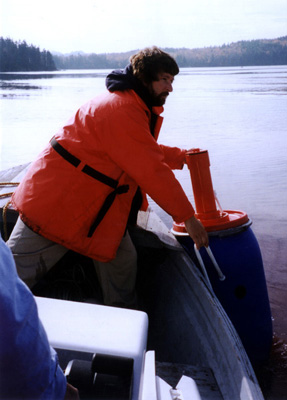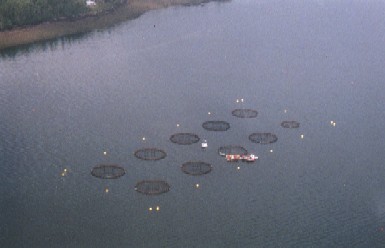Coastal Oceanography
Studies of commercially important coastal zones and offshore regions provide the basis for safe and sustainable utilization of our marine resources. Research activities conducted in this area include monitoring water temperatures, salinities, meteorological conditions, as well as measuring and modelling the water circulation and transport pathways of water and suspended substances.

Dr. Page deploying a surface drifter, used to track the movement of surface water.
These studies help define important physical attributes, such as circulation and flushing rate of an area, and refine monitoring strategies for critical properties, such as temperature and salinity. Support is also provided to industries and regulatory agencies through participation in multi-disciplinary development and impact studies and by providing site-specific information to interested parties.
Sustainable Aquaculture
The development of a diversified and sustainable aquaculture industry in coastal zones depends, in part, on identifying the environmental conditions of importance to aquaculture production and selecting the sites that have the most suitable habitat. As well, because ocean conditions are ever changing, it is important to look at past and present trends and ultimately, to try to predict future conditions. At present, the geographic focus for the program includes southwestern New Brunswick (SWNB) and other parts of Atlantic Canada.

Aerial view of a typical salmon aquaculture site in southern New Brunswick.
These areas are important because of their large mussel and salmon culture industries. In the coastal zone where the present salmon culture industry is located, the oceanographic conditions vary on short time and space scales because of the complex topography, the input of fresh water, atmospheric heating, and wind conditions.
Other work has included a study of pesticide dispersal rates, measurement of currents in over 100 locations and monitoring of hydrography and phytoplankton community structure within the SWNB area. In collaboration with Dr. David Greenberg (BIO), three-dimensional tidal circulation models for the SWNB area have been, and continue to be, developed. We are also a partner in the IMTA project.
Environmental Statistics
Another research interest of the OSD group is the development of novel data analysis methods for the interpretation of coastal oceanographic observations, including remotely sensed observations.
One recent example is the analysis of historical data from Ms. Jennifer Martin's (SABS) regional toxic plankton monitoring program. The OSD group, together with Ms. Martin and Dr. Alex Hanke, has begun analysing the plankton data to identify spatial and temporal patterns. One promising avenue of interest has been the statistical analysis of plankton time series using approaches designed to detect significant year-to-year changes in abundance. Page is also researching the nature of the phytoplankton community structure and how this is associated with the physical oceanography of the region.
Models for Marine Ecology
The development of mathematical models of marine ecosystems are needed both to understand how these systems work, as well as to predict ecosystem changes caused by factors such as climate change or coastal development, including aquaculture.
Models of the effect of aquaculture on the benthic environment and on the concentration of dissolved oxygen within, and adjacent to, aquaculture sites is also being researched.